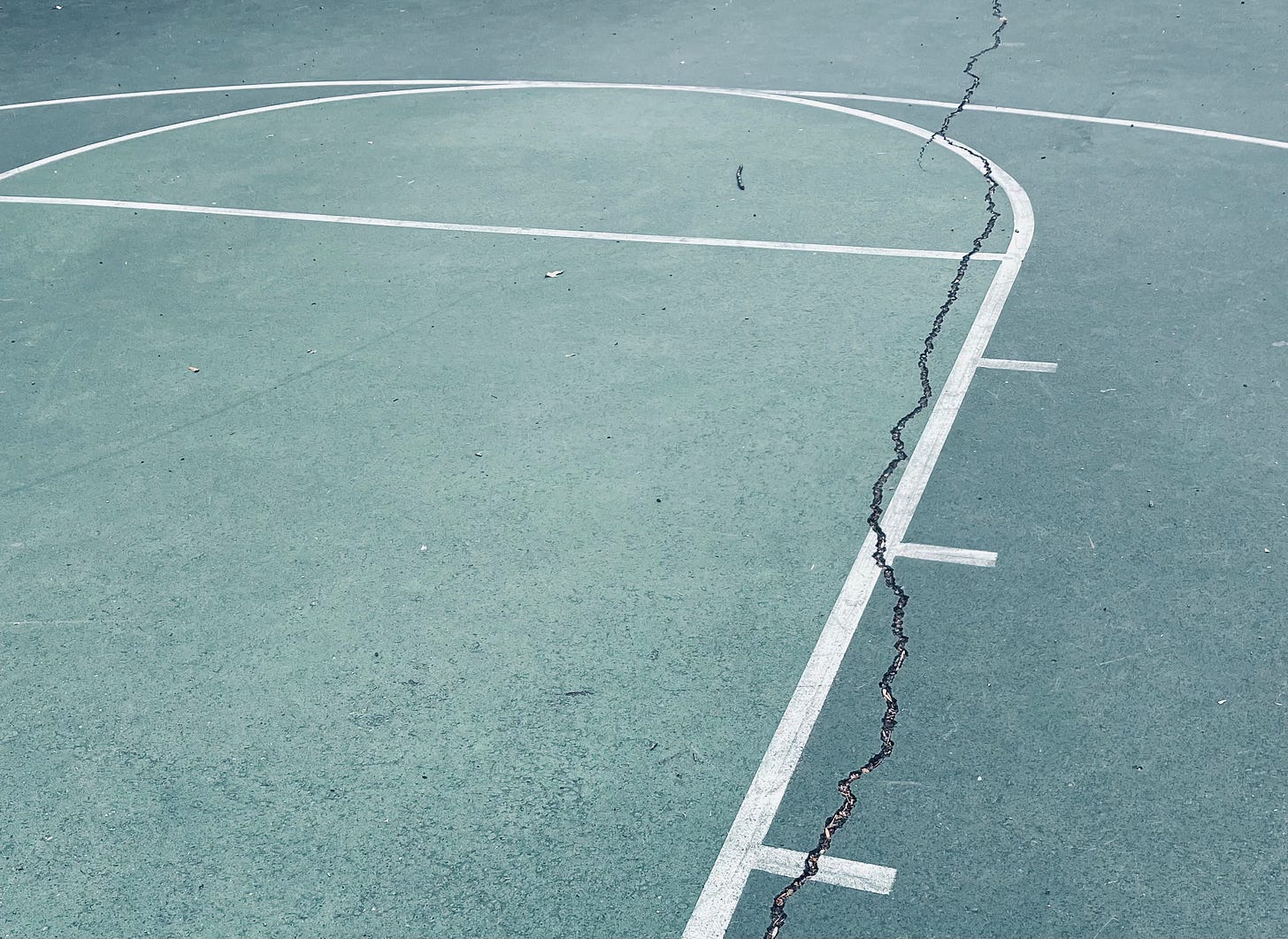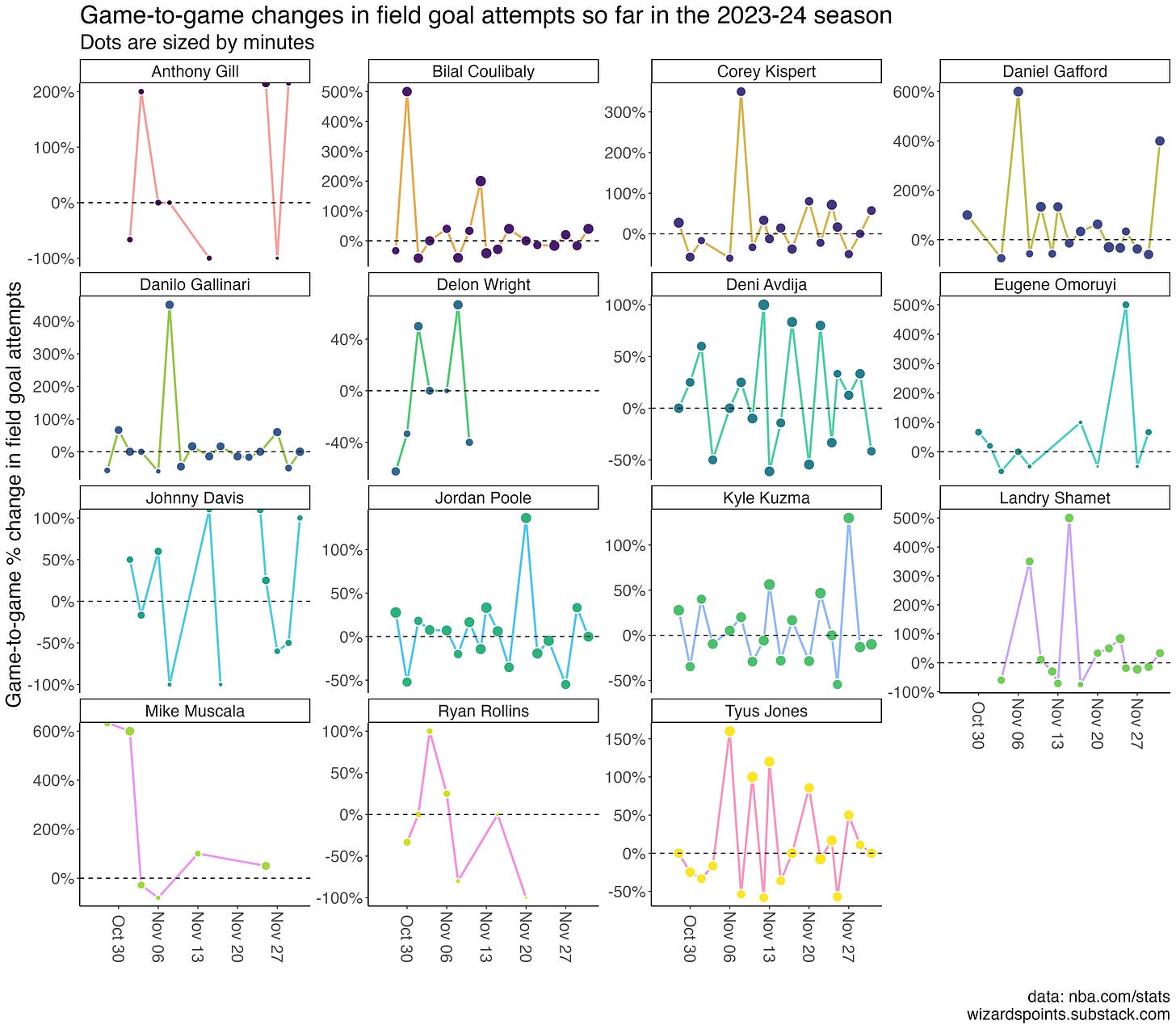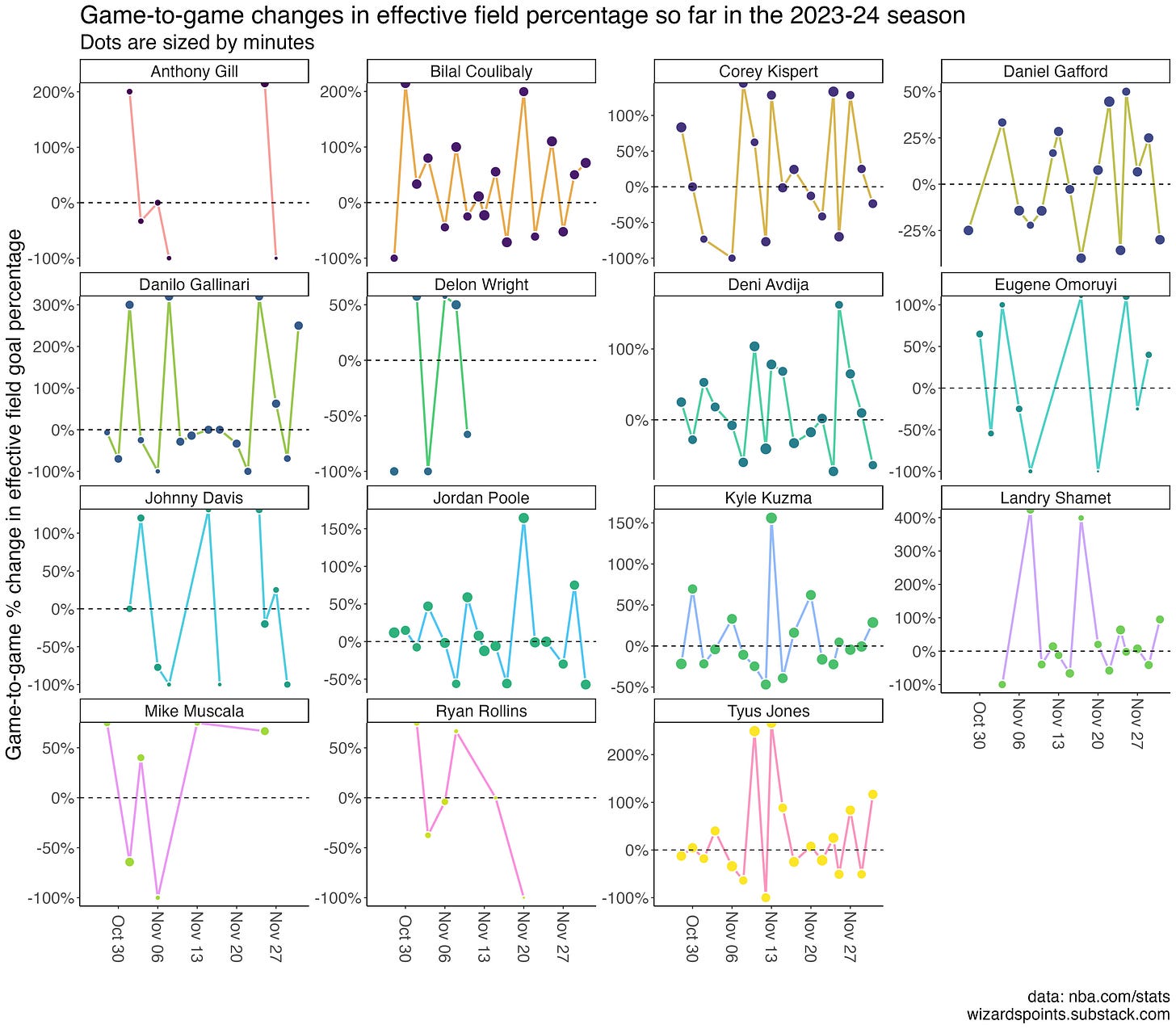In this rebuilding season, in any season really, the point is to see some progress. Incremental progress is fine. But progress. We’re already seeing some shifts 19 games into the season. Three years ago after a January loss, Bradley Beal said the Wizards, “couldn’t guard a parked car.” Last week, Kyle Kuzma said the Wizards “couldn’t guard a stop sign.” This isn’t exactly the move away from the Beal era fans were looking for. Though if Deni Avidja explains that the team can’t guard a locked bicycle during training camp next year it might be time to call it quits on this whole Wizards thing. Even if progress is the goal, it’s tough to know what success looks like when you’re staring at a 3 and 16 record. Would it be better if we had the same record, but the youngest players were getting increasingly more minutes? Maybe! Is the team learning and adjusting nearly 20 games in? Some nights it looks like it, other nights are a toss up.
This is not the season to lean on box score stats. The in-season tournament and new rules about rest have changed, at least marginally, how opposing stars have played against the Wizards. And, just to get this out of the way now, this is not a team built to win. At this point last season, coach Wes Unseld Jr. had put out 250 different line-up combinations, while this season he has fielded 210 different line-ups, which speaks to the lack of, uh, legitimate options. Still, as a data guy, I do think the numbers can point to which guys are adjusting. Do we see game-to-game changes? Is WUJ actually playing people more or less from game to game? None of this is predictive of how things will go for the remaining three quarters of the season, but it’s worth checking in on the rebuild with the info we have so far.
The main way I have been thinking about this is in game-to-game changes across key metrics. To start, let’s look at minutes. This is really a way to assess the extent to which Coach Wes Unseld Jr. is adjusting based on how guys are playing and also how guys are holding up. The figure below shows the percentage change game to game.1 For example, in the November 10th game against Charlotte, Bilal Coulibaly played 19.6 minutes; in the next game against Brooklyn he played 33.9 minutes. This is a 73% increase in minutes from one game to the next, which is a big jump!
A big percentage change in the number of minutes played is not necessarily a good or bad thing. A jump from 10 minutes to 15 minutes (i.e., a 50% increase) back down to 10 might just be a function of who the match-ups were, how guys were feeling, and so on. But what stands out is who is seeing huge swings in their court time. For example, Landry Shamet, who has been one of the better two-way players so far this season, has seen his minutes bounce around pretty dramatically from nearly 21 minutes to 6 minutes to 14.5 all in the course of three games. Again, this isn’t inherently bad. Every season takes a while to find an equilibrium. But it does highlight some of WUJ’s decision making around who is on the court and for how long, about who is getting pulled or not after a bad game or bad quarter.
If I have one complaint about the season so far, it’s that I would like to see the younger guys, like Bilal, Corey Kispert, and, even though he’s had usage around 25% for some games, Deni Avdija, get more touches. Unfortunately, I have many complaints, but this is one that tends to resurface each time Jordan Poole misses another contested 30 footer with 18 seconds on the clock.
Taking the same logic as the prior graph but with field goal attempts, we can see that Bilal Coulibaly has been pretty consistent in his attempts. This is a problem. I’d like to see Bilal be given the ball and freedom to just let it rip, even if it means taking a game of contested 30 footers with 18 seconds on the clock. He is the future of the team more than anyone else. Right now, he’s averaging six field goal attempts per game. It would be great to see that gradually increase over the next 20 games.
Deni Avdija is averaging 9.2 attempts per game, but with a lot of up and down. Deni overall is having his best season and looks a lot more focused on the court. Setting aside a brutal showing against Milwaukee, where he only went for five attempts, Deni seems to be making the most of his minutes, with a 61.5% effective field goal percentage in games with 24 minutes or more (league average is 54% per basketball-reference.com) .
And while I don’t want to get too hung up on whether or not guys are hitting their shots (the key thing for developing young talent is just getting reps in), let’s look at actual effective field goal percentage (i.e., number of shots made vs. those attempts, taking into account that threes count for more points).
This one is kind of confusing because it’s the percentage change of a percentage. For players like Corey Kispert, with a career 59.8% effective field goal percentage, i.e., someone who reliably tends to hit more than half of their shots, any of the lines going up is really really good, but also kind of tough, while any lines that drop below zero are not necessarily a sign that things have fallen off the rails. There’s just a natural amount of variation in the percentage of shots players hit. That said, I see figures like Bilal’s and Daniel Gafford’s below as pretty good. After each downturn, they seem to have bounce back games. Gafford had an effective field goal percentage of 77.8 in the November 22nd game against the Hornets, dropped down to 50% against the Bucks, but was back up to 75% the next game against the Hawks a day later. This is both reflective of how tough the Bucks are and how bad Charlotte is, but the Hawks are a physical team and Gafford was able to fight through Clint Capela and Onyeka Okongwu to get buckets.
It is too early to say anything about the rebuild. The main value of tuning in to each game these days is to see how guys adjust game to game. It’s weird to say, but my interest is less in any single game than in stretches of games that might present different tests for specific players. It has been great to see guys like Deni and Bilal miss assignments or make bad turnovers one game and seemingly make a point to avoid doing the same thing the next game. It’s a small thing, but it is progress. To quote James Baldwin wildly out of context, “if people did learn from history, history would be very different.” We don’t know whether or not the Wizards are truly learning here, and the data only tell some of the story, but we can already see how game to game shifts are taking place, who is bouncing back from tough match-ups, who is going above their average play, and whose game is still getting worked out.







